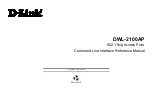
96
RTS Threshold
The IEEE 802.11n ZAC Access Point sends RTS (Request to Send) frames to certain receiving
station and negotiates the sending of a data frame. After receiving an RTS, that STA responds
with a CTS (Clear to Send) frame to acknowledge the right to start transmission. The setting
range is 0 to 2346 in byte. Setting it too low may result in poor network performance. Leave it at
its default of 2346 is recommended.
Fragmentation Length
Specify the maximum size in byte for a packet before data is fragmented into multiple packets.
Setting it too low may result in poor network performance. Leave it at its default of 2346 is
recommended.
Beacon Interval
Specify the frequency interval to broadcast packets. Enter a value between 20 and 1024.
DTIM Interval
DTIM, which stands for Delivery Traffic Indication Message, is contained in the data packets. It is
for enhancing the wireless transmission efficiency. The default is set to 1. Enter a value between
1 and 255.
Preamble Type
It defines some details on the 802.11 physical layer.
“
Long
” and “
Auto
” are available.
IGMP Snooping
Available in AP/Router mode, IGMP snooping is the process of listening to IGMP network traffic.
By enabling IGMP snooping, the AP will listen to IGMP membership reports, queries and leave
messages to identify the ports that are members of multicast groups. Multicast traffic will only be
forwarded to ports identified as members of the specific multicast group or groups.
RIFS
RIFS (Reduced Interframe Spacing) is a means of reducing overhead and thereby increasing
network efficiency.
Link Integration
Available under AP/Bridge/AP repeater mode, it monitors the connection on the Ethernet port by
checking
“
Enabled
”. It can inform the associating wireless clients as soon as the disconnection
occurs.
Содержание ZN-7200-2AEI-L
Страница 1: ...1 ZN 7200 2EI O ZN 7200 2AEI O ZAC Wireless Access Point User s Manual V1 1 Sep 2014...
Страница 11: ...11 Hardware Overview Front View Back View...
Страница 65: ...65...















































